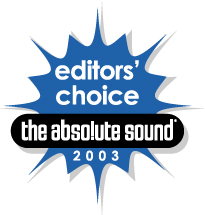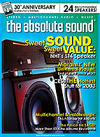Special 25 Presse


The Absolute Sound, April/May 2003 (issue #141)
Dynaudio Special Twenty-Five LoudspeakerANNA LOGG
The adage that “good things come in small packages” certainly applies to these Dynaudio 25th Anniversary “Special Twenty-Five” edition loudspeakers. These deceptively small two-way speakers (8.8" x 16.7" x 13.8") present such remarkable transient response, room-filling soundstage, grain-free upper midrange and treble, and amazing (for their size) 35Hz low end, they might even be considered a bargain at $4,800!
This is a unique design, only for this limited edition, although the technologies and drivers have been proven in flagship Dynaudio models and are considered state of the art. Here Dynaudio aimed at downsizing it all into a “compact” speaker (Dynaudio’s preferred description). What the company created was a pair of small wonders with bigboy driver technology, components, construction —and sound that rivals the performance of some full-range speakers I’ve heard that cost up to twice as much.
Dynaudio started out as a speaker manufacturer engineering its own enclosures and crossovers, but dependent upon suppliers for drivers. The desire to produce a truly great loudspeaker led the company to develop its own driver complement, and this R&D continues to this day. The Special Twenty-Fives are my first Dynaudio products, and I understand why they have such a passionate following. Effortless, soaring treble and remarkable overall coherence from top to bottom are only the beginning. Dynaudio shows us how it’s done with its extraordinarily rigid cabinet construction and resultant sound that defies the speaker’s visual presence. (Translation: They are dead quiet; they disappear.) All Dynaudio speakers are handcrafted and tested at the factory in Denmark.
While the soundstage is marginally not as deep as my Von Schweikert 4s, stage width extends beyond both side walls in my room. The Dynaudios are slightly forward in their presentation, but the Special Twenty-Fives don’t overdo this—it’s much like having a fifthrow seat, but never overpowering. They should be placed at ear height on well-damped stands, away from back or side walls. Dynaudio supplies a pair of sponge cylinders for the rear ports to minimize reflections if the speakers have to be placed close to a back wall, but there is no mention of these in the set-up instructions. I found also that positioning them straight-on allowed the widest dispersion and sweet spot. Dynaudio provided the stands, though I also used Vibrapods under the speakers, which really helped to isolate and dampen them to the maximum degree.
Transient response is so good that after a few minutes of listening I stopped thinking about it, and any noise you hear will have to come from the recording or your upstream components. Whether on complex instrumental lines of big-ensemble classical works, or the subtleties of solo, duo, or small-ensemble works in classical, pop, or jazz, these speakers’ articulation and dynamic response are about as good as I’ve heard. They have an airy, unfettered sound, yet retain the definition and visceral slam of dynamic speakers. Let’s take, as an example, one of my favorites, the Philadelphia Orchestra/Ormandy recording of Bizet’s L’Arlesienne Suites, now available remastered on CD [Sony]. The string basses growl resinously through the opening bars of the Prelude, and the violins throughout have that wonderful juxtaposition of sweet-smooth and gutty,. The reed instruments in the Carillon all have their own spaces and sonic signatures, with air and depth around everything. And you can hear the players’ breath in the piccolo passage in the Pastorale. When a speaker lets the beauty and “life” emerge from all your records, not just the “audiophile” favorites, it deserves high-end status.
Of course, for the bottom octave you’d need to add a subwoofer, but I point this out only because the mid-30s at the low end are no longer considered “deep” bass. However, this is where many so-called full-range speakers stop (and at far higher prices than for the Special Twenty-Fives), so getting a clean, honest 35Hz out of a box this size is news. Listeners who have space con- straints will drool over the definition and whomp the Special Twenty-Fives deliver at the low end. Last, while I found them to be remarkably transparent and neutral, they never crossed the hated line into being too analytical. They remained musically involving. They were, to be sure, slightly bright at first: The review pair took over 100 hours to smooth out in the upper midrange and lower treble.
As for the inside story, the 8" woofer created especially for the Special Twenty-Fives is based on and built to the same level as those designed for Dynaudio’s flagship, the $85,000 Evidence. It uses a neodymium magnet
that Dynaudio says “dramatically improves the sensitivity in contrast to traditional ferrite magnet structures.” As a result, Dynaudio avers that in a “small” room, the Special Twenty-Fives can be driven with a nearly flea-powered 15Wpc amp (triode lovers alert); in a “medium-sized” room (probably like my 14- x 17-foot room), they’ll perform well with a minimum of 40Wpc, then get hungrier for around 100Wpc in “large-sized” rooms. An oversized aluminum- wire voice coil “further improve[s] efficiency and cone control.” And “the moving system consists of a geometrically formed one-piece magnesium polymer (MSP) cone which is bonded to an extremely stiff Kapton voice coil former…[that] minimizes loss in the woofer and ensures high thermal resistance and long excursion.” Engineering technospeak aside, what I hear is a strong middle and upper bass with clean articulation and superb tonality. Similarly, the Dynaudio Esotar2 1.1" soft-dome tweeter was first developed for its upscale Confidence C2 and C4 speakers. Dynaudio notes: “An important consideration for modern digital formats, the frequency response [of the tweeters] stays free of peaks up to 25kHz and beyond.” Suffice it to say that I can attest to the excellent transient response; with this tweeter, highs are presented as true instrumental sounds that seem to float freely in space.
The first-order crossover (“high/lowpass slope for correct phase and linear impulse response”) is divided into two parts mounted on both sides of an aluminum plate that functions as a heat sink. This unique configuration allows resistors to be mounted on one side, while capacitors and inductors are mounted on the other, i.e., on two distinct circuit boards. The crossover point (at 2.4kHz) is undetectable. The speakers have those fabulous WBT binding posts (single-wire), commensurate with the rest of the top-quality parts used throughout.
Last, the Special Twenty-Fives go through no less than 80 “quality checks” and come with an unprecedented 25- year warranty. The speakers are handbuilt in matched, numbered pairs (the review pair was No. 241), finished in an “exclusive cross-grained birch veneer” (other finishes available by request).
These speakers are capable of providing large-work, large-soundstage grandeur. Try the opening scene of the complete opera, Turandot [RCA LP, Leinsdorf, Nilsson, Bjoerling, Tebaldi]. The huge chorus, enormous orchestral climaxes, and vocal color are all there. The dynamic swings from chorus to soloists, from bombast to delicate points, as in the hush of the crowd at the first appearance of Turandot, occur so instantaneously against a dead-quiet background that they sound pleasurably real. Then, for sheer visceral impact, try the organ-based overture to Phantom of the Opera [Kunzel/Cincinnati Pops, Telarc, CD], or the Atlanta Symphony’s whamslam version of Copland’s Fanfare for the Common Man [Telarc]. Even on these little speakers, those drum whacks are taut and controlled, and come close to rattling the windows. If you have been thinking, “Hey, good apartment speakers,” be aware that they have the potential to get the attention of your neighbors. Try Springsteen, John (Elton or Lennon), or Pink Floyd—these are great party speakers, if not lease-breakers.
I can imagine living with these speakers for a long time (though I’d probably want to add a sub). Parting with them won’t be easy.
ASSOCIATED EQUIPMENT
Balanced Audio Technology VK-50SE and HCAT P12 preamplifiers; Musical Design Signature II CD player; Van Alstine OmegaStar DAC; Balanced Audio Technology VK-P10 phono stage; WireWorld Gold Eclipse interconnects; Vampire speaker wire; Sota Star Sapphire turntable; Premier MMT arm; Grado “The Reference” cartridge; Vibrapods.
Quelle: Dynaudio